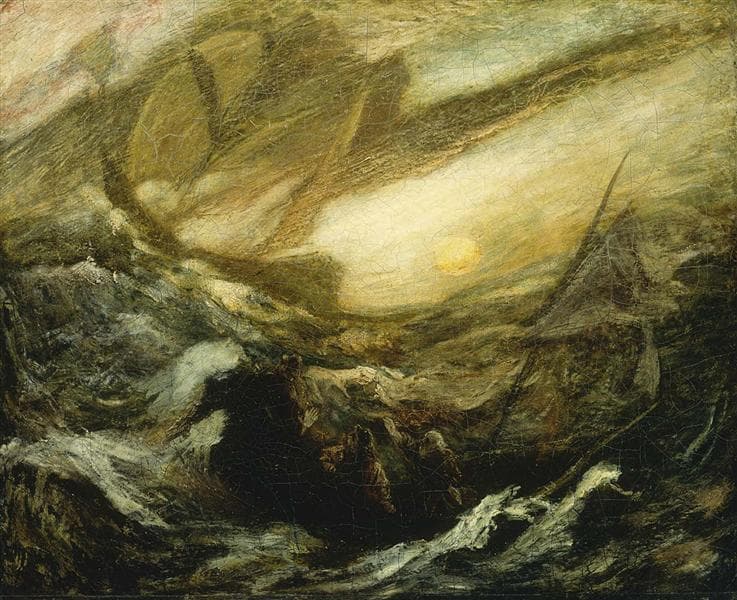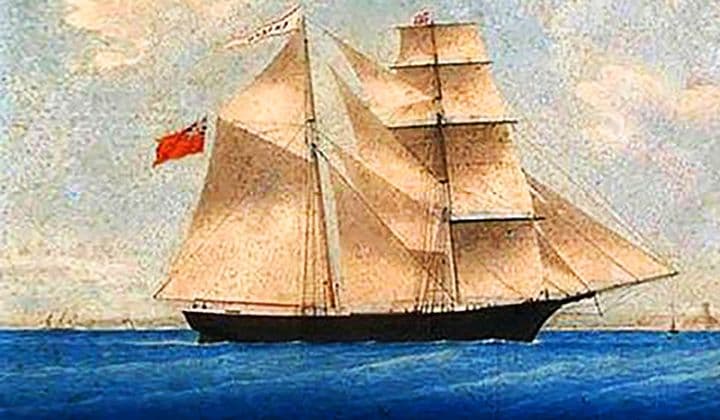Top 5 Ghost Ships in Naval Folklore
Across centuries of seafaring, a handful of phantom vessels have captured imaginations and inspired operas, novels, films and even video games. Here are the five most famous ghost-ship legends: where and when their stories first arose, and the key works they have spawned.
Flying Dutchman (Europe, 17th Century)
Image: The Flying Dutchman by Albert Pinkham Ryder (c. 1887).The Flying Dutchman is one of the most famous ghost ship legends in maritime history. According to the myth, it's a Dutch vessel doomed to sail the seas for all eternity, never able to reach land or find peace. The story began with 17th-century sailors, who believed that seeing the ship was a terrible omen, often predicting disaster or death at sea.
As the legend goes, the ship's captain, often named Vanderdecken or simply "the Dutchman", tried to sail around the Cape of Good Hope at the southern tip of Africa, a region infamous for brutal storms and treacherous waters. When his ship was caught in a violent storm, he refused to turn back. Instead, he swore he would make it around the Cape, no matter what it cost even if it meant sailing forever. That reckless and defiant vow sealed his fate. In punishment, he and his crew were cursed by the devil in some versions or by God in others, to sail the oceans for all eternity, never able to reach land or find rest.
The Flying Dutchman is often described as glowing with a ghostly light, sometimes with torn sails and no crew in sight. Other times, shadowy figures are seen on board, sailors who are doomed to relive their final voyage endlessly, appearing as pale, hollow-eyed phantoms. Ships that claim to have spotted it say it either vanishes suddenly or sails straight through storms that would sink any normal vessel.
The tale spread through sailor folklore and literature. The first written account appeared in 1790 in John MacDonald's travel memoir Travels in Various Parts of Europe, Asia and Africa. It was later made famous in Frederick Marryat's 1837 novel The Phantom Ship, which dramatized the story of Vanderdecken and his cursed crew. Then, in 1843, composer Richard Wagner turned the legend into a dark, emotional opera, Der fliegende Holländer, which is still performed today.
Mary Celeste (Atlantic, 1872)
Image: Painting of the Mary Celeste adrift (artist unknown, c. 1861).On December 4, 1872, the American merchant ship Mary Celeste was discovered adrift in the Atlantic Ocean near the Azores Islands. The sails were only partially rolled up, the lifeboat was missing, and the ship showed no signs of damage or violence. Inside, everything appeared normal, personal belongings were untouched, over 1,700 barrels of alcohol were still in the hold, and food was still simming in the galley. But the entire crew, including Captain Benjamin Briggs, his wife, and their two-year-old daughter, had vanished without a trace.
The mystery shocked the world and gave rise to endless speculation. There were no signs of foul play, no distress signals, and no clear reason for the abandonment. Many theories were suggested, from pirate attacks and mutiny to sudden storms or toxic gas leaks, but none have ever been proven.
The case inspired many fictional retellings. In 1884, Arthur Conan Doyle wrote a popular short story, J. Habakuk Jephson's Statement, which helped turn the Mary Celeste into a legend (though he renamed the ship “Marie Celeste”). In film, the best-known adaptation is the 1935 mystery thriller The Mystery of the Mary Celeste, starring Bela Lugosi. The most comprehensive modern investigation is found in Brian Hicks's 2005 nonfiction book Ghost Ship, which explores every known clue and theory with fresh insight.
Over 150 years later, the fate of the Mary Celeste remains one of history's most enduring maritime mysteries. Her empty deck still invites one haunting question: what happened to those who sailed her?
Who Was On Board?
Contemporary records show ten souls:
| Name | Role | Age | Nationality |
|---|---|---|---|
| Benjamin S. Briggs | Captain | 37 | American |
| Sarah Elizabeth Briggs | Captain's wife | 31 | American |
| Sophia Matilda Briggs | Daughter | 2 | American |
| Albert G. Richardson | First Mate | 28 | American |
| Andrew Gilling | Second Mate | 25 | Danish |
| Edward W. Head | Steward & Cook | 23 | American |
| Volkert Lorenson | Seaman | 29 | German |
| Arian Martens | Seaman | 35 | German |
| Boy Lorenson | Seaman | 23 | German |
| Gottlieb Gondeschall | Seaman | 23 | German |
No other crew, passengers or stowaways were reported.
SS Ourang Medan (Strait of Malacca, c. 1947)
Illustrative image: "Steam on the Atlantic" by Victor Qvistorff (1883-1953). Used here as a visual reference to represent the type of freighter associated with the legend of the Ourang Medan.The SS Ourang Medan is widely regarded today as a maritime urban legend rather than a documented historical event. The story first surfaced in 1948, when a brief report by Italian journalist Silvio Scherli described a Dutch merchant ship found adrift in the Strait of Malacca after sending a short Morse-code distress call.
According to later retellings, the message read, “All officers including the captain are dead, lying in chartroom and bridge. Possibly whole crew dead,” followed by a final transmission, “I die…” However, no original radio logs or officer reports have ever been produced, and there is no record of the distress broadcast in naval or shipping archives.
Subsequent versions embellished the tale with grisly details of the crew found frozen in terrified poses, but they are not supported by any contemporary rescue report or eyewitness testimony.
Efforts to verify the vessel's existence have come up empty. No entry for SS Ourang Medan (or any close name) appears in Lloyd's Register of Ships, Dutch maritime archives, or any other reputable shipping database. No harbor masters, insurers, or naval investigators ever produced logs, manifests, or casualty lists relating to this ship.
Various theories have been proposed to explain the legend:
- A misreported or hoaxed 1948 newspaper dispatch, later amplified by sensationalist media.
- A wartime cover-up involving dangerous cargo (e.g., chemical agents), though no declassified documents support this.
- The story likely grew over time, with each retelling adding new details to make the tale more dramatic and mysterious.
Caleuche (Chiloé Archipelago, undated – first recorded 1909)
Image: Concept art of the ghost ship Caleuche from the poster of Caleuche: The Call of the Sea (2012).The Caleuche is a mysterious ghost ship from the folklore of the Chiloé Islands in southern Chile. According to legend, it sails the dark waters at night, its decks aglow with countless lanterns that "dance" across the waves. Locals say the lanterns guide the souls of drowned sailors aboard the phantom vessel, offering them a passage between the realms of the living and the dead.
Stories of the Caleuche have been passed down through generations by Chilote fishermen and storytellers. Some believe the ship appears only to those who have lost loved ones at sea, while others claim it offers endless feasts and music for anyone brave enough to board. In many tales, the Caleuche can change shape or cloak itself in fog, making it vanish as suddenly as it arrived.
Many scholars think the legend of the Caleuche grew from a mix of indigenous Mapuche beliefs and European ghost‐ship stories, like the famous Flying Dutchman. The first time the name “Caleuche” showed up in print was around 1909, but the stories about it were told by the people of Chiloé long before that.
In modern popular culture, the ship's haunting imagery lives on. Chilean filmmaker Raúl Ruiz wove the Caleuche into his surreal 1983 film Three Crowns of the Sailor, while horror director Jorge Olguín brought it back to life in 2012's chilling Caleuche: The Call of the Sea. Even today, the legend continues to inspire writers, artists, and filmmakers around the world.
Lady Lovibond (Goodwin Sands, 1748)
Image: A stormy sea by Ivan Aivazovsky (1872), evoking the wild waters where the legendary Lady Lovibond was said to be lost.The story of the Lady Lovibond is one of the most romantic and tragic maritime legends of all time. According to the tale, the ship set sail on February 13, 1748, just a day before Valentine's Day. It was a special voyage, Captain Simon Reed had brought his new bride aboard for a honeymoon cruise along the English coast. But love quickly turned to disaster. Unbeknownst to the captain, his first mate, John Rivers, was secretly in love with the bride and overcome with jealousy.
Blinded by rage, Rivers reportedly seized the ship's wheel and deliberately steered the Lady Lovibond straight into the deadly Goodwin Sands, a stretch of submerged sandbanks off the coast of Kent, England, known for wrecking ships. The vessel was smashed to pieces, killing everyone on board. From that day forward, the Lady Lovibond was said to be cursed, doomed to repeat its final journey through the centuries.
Legend claims that every 50 years, on the anniversary of its wreck, the ghost ship reappears, sailing once more toward the Goodwin Sands. Reports of sightings came in 1798, 1848, and 1948, each describing a glowing, fully-rigged schooner drifting silently through the mist before vanishing without a trace. Despite these accounts, no official maritime records from 1748 survive to confirm the ship's existence or the tragedy. Still, the story has become a permanent part of nautical folklore, especially around Valentine's Day.




